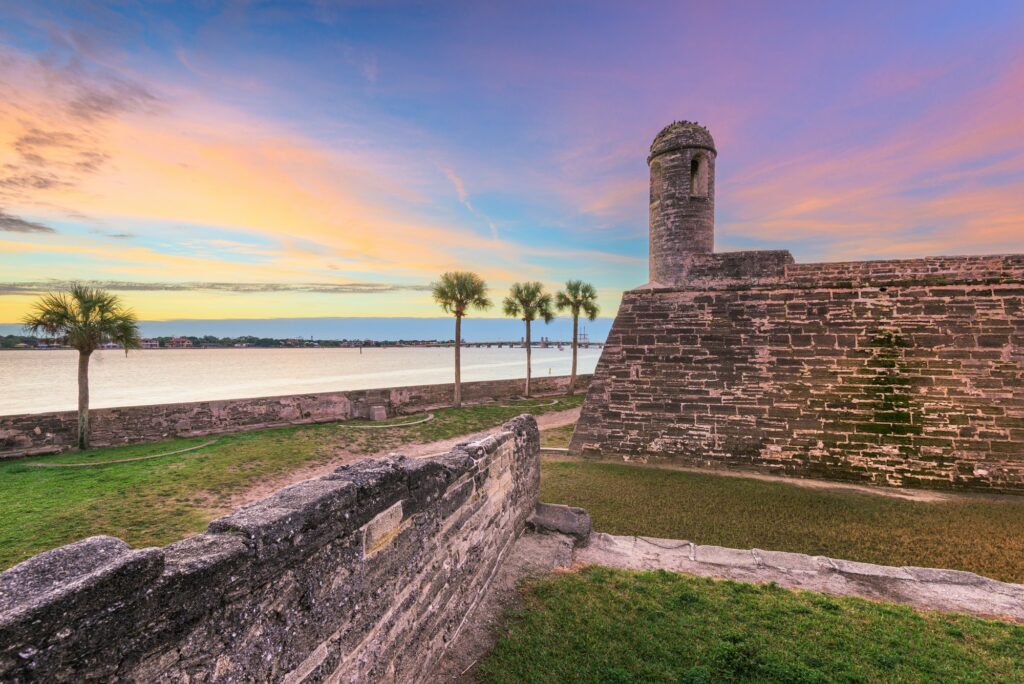The history of St. Augustine is fascinating. Founded on September 8th, 1565, by Spanish explorer Pedro Menendez de Aviles, the conquistador originally named the settlement ‘St. Augustín’. He arrived with supplies, soldiers, and settlers from Spain with the intention of establishing a stronghold in the area, which he achieved success. From their fleet, Menendez and his crew first sighted land eleven days earlier, on August 28th, on the feast day of St. Augustine, which is how the city got its name.
St. Augustine is the oldest European-established settlement that has been continuously inhabited in the entire United States. The city has played an important role in the history of Florida, serving as the capital of Spanish Florida for more than two hundred years. It also served as the capital of British East Florida when the colony was formed in 1763. With such a rich and fascinating history, there are countless interesting facts about the history of St. Augustine that many people do not know. Whether you are a history buff, a student or you are simply interested in knowing more about the history of St. Augustine, uncovering some of these lesser-known facts is important in understanding the significant impact that St. Augustine has had on the history of Florida.
Let’s take a look at some alluring facts about the history of St. Augustine that you might not have known.
Previous Missions To Settle Did Not Go Well
Before Pedro Menendez de Aviles and his crew landed in St. Augustine, there were many attempts made by the Spanish to colonize Florida. In the forty-six-year period from 1513 to 1559, several expeditions departed for Spain on a mission to establish settlements in Florida. Unfortunately, these expeditions did not go according to plan, with one failure after the next.
Juan Ponce de Leon’s mission was put to a grinding halt when he was killed by a flying Native Indian arrow. Hernando de Soto’s expedition led to three years of exploration, culminating in him dying of disease. Spanish magistrate Lucas Vázquez de Ayllón successfully established the first European settlement in modern-day Georgia in 1526, but it was abandoned after a few short months. In 1559, another Spanish settlement was established in present-day Pensacola, which lasted two years. After so many failed attempts, the Spanish monarch, King Philip II, ended efforts to colonize the Florida region.
The Main Purpose Was To Banish The French
After withdrawing from the idea of colonizing Florida, King Philip II reassessed his decision, when he learned that French Huguenots had built Fort Caroline and established a settlement on the site of present-day Jacksonville. As a devout Catholic, King Philip II had every intention of banishing the French Protestants from their new home.
Pedro Menendez de Aviles and his crew left Spain in the summer of 1565 on a mission to oust the French from the region. After establishing St. Augustine on September 8th, 1565, he and his men marched north to Fort Caroline to destroy the fort and kill as many of the French Huguenots as they could. After the attack on Fort Caroline, he learned of a number of French boats that were marooned further down the coast. They tracked down the shipwrecked French soldiers and massacred the majority of those that they found at, what is known nowadays as the Matanzas Inlet, so named as “Matanzas” which means “slaughter” in Spanish.
Many Attacks From A Variety Of Forces
There were numerous attacks on St. Augustine over the years with a range of different groups and forces. Everywhere the Spanish landed in the New World, they would clash with the local Native Indian tribes and things were no different at St. Augustine. There were many battles between the local people and Spanish colonizers, with the Native Indians reportedly setting fire to the city’s fort walls using flaming arrows in one of their interactions.
In 1586, the city was under attack again when an English privateer, Sir Francis Drake, arrived accompanied by two thousand men. He and his men burned the city to the ground, taking all that they could, and then sailed away. While this was happening, many of St. Augustine’s residents stayed out of sight in the wooded areas nearby.
There were further attacks on the city in 1665 by English buccaneers who completely ransacked the settlement, and in 702 and 1740 the governors of Georgia and Carolina carried out sieges on the city. Despite all of these attacks and more in later years, the city always rebuilt itself successfully.
Proclaimed A Safe Haven For Runaway Slaves
While the use of slaves was prominent in the British colonies to the north, the Spanish were not quite as supportive of the use of slaves. Recognizing the disadvantage that this position could result in, King Charles II of Spain proclaimed that St. Augustine would be a safe haven for any runaway slaves from British settlements. In 1963, the Spanish monarch declared that any slaves that left British land would be given their freedom in Florida, with the caveat that they convert to Catholicism.
In 1738, just forty-five years later, the governor of Florida, Manuel de Montiano, constructed and established a settlement called Fort Mose, just north of St. Augustine, where ex-slaves could live. This was the first legally-sanctioned free black settlement in all of North America.
Learn More About The History of St. Augustine And Its Influence On Florida’s History
Take the time to learn more about the fascinating history of St. Augustine and find out more about the impact this important city has had on the Florida region. From its founding on September 8th, 1565 to the modern-day, St. Augustine continues to play a crucial role in the development of Florida. There are countless historical facts and stories just waiting to be uncovered, so make sure you take the time to dive into the exciting and alluring history of St. Augustine to familiarize yourself with all that has taken place here over the years.
